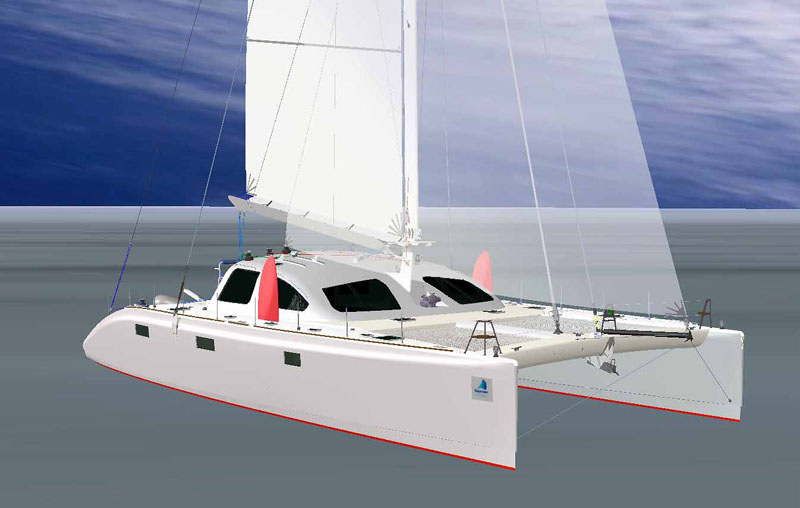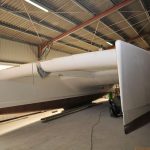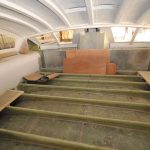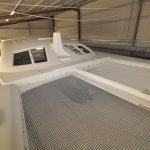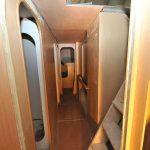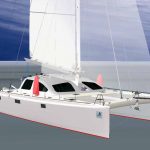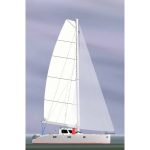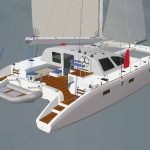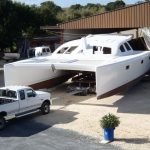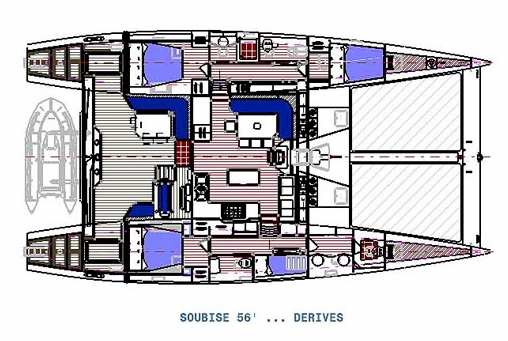- MAIN CHARACTERISTICS
- MATURE & SAILS
- ENGINE & OTHER INFO
| Designer : Philippe TOURNIER | ||
| Brand : TOURNIER MARINE | ||
| MAIN CHARACTERISTICS | STANDARD | PRESTIGE |
| Length overall | 17 m | 17 m |
| Length at waterline | 16,75 m | 16,75 m |
| Width | 9,20 m | 9,20 m |
| Draft (rudders) | 1,20 m | 1,20 m |
| Draft (small keels) | 1,45 m | 1,45 m |
| Draft (daggerboards) | 1,20/2,80 m | |
| Clearance | 1,02 m | 1,02 m |
| Water capacity | 2 x 335 liters | 2 x 335 liters |
| Light displacement | 13 Tons | 13 Tons |
| Load displacement (accord. to versions) | 15 Tons | 15 à 19 Tons |
| Displacement for calculation | 20 Tons | 20 Tons |
| STANDARD | PRESTIGE | |
| MASTING | ||
| Mast | fixed, aluminium | rotating, carbon |
| Rigging | 7/8ème | 7/8ème |
| Mast length | 21,50 m | 23,50 m |
| Mast surface | 13 m² | |
| Mast clearance | 26 m | 28,00 m |
| STANDARD SAILS | ||
| Square headed mainsail | 117 m² | 128 m² |
| Jib on furler | 70 m² | 74 m² |
| Staysail on furler | 49,50 m² | 55 m² |
| OPTIONAL SAILS | ||
| Head drifter on head | 117 m² | 120 m² |
| Asymmetrical spi on hounds on pole | 171 m² | 180 m² |
| Maximum surface at close hauled | ||
| in light winds | 234 m² | 261 m² |
| Maximum route surface at close hauled | ||
| (mainsail + jib) | 187 m² | 215 m² |
| (mainsail + staysail + jib) | 236,50 m² | 270 m² |
| STANDARD | PRESTIGE | |
| ENGINES | ||
| In aft compartment | 2 x 55 Hp Diesel | 2 x 75 Hp Diesel |
| saildrive | saildrive | |
| Diesel-oil capacity | 2x200 liters | 2x250 liters |
| LAYOUT | ||
| Owner | 3 cabins | 3 cabins |
| Charter | 4 cabins | 4 cabins |
| Saloon area | 18 m² | 18 m² |
| Cockpit area | 21 m² | 21 m² |
| CONCEPTION CATEGORY | A | A |
| (10 people | (10 people | |
| considered) | considered) | |
| CERTIFIED ORGANISM | E.C.B. European Certification Bureau Volendam (Netherlands) | |
For any requests for additional information or prices
Please contact Us
NOTES FROM THE YARD
“Lhe SOUBISE 56’ is a logical answer for travel and life onboard. She is fitted to be sailed with a familial crew, with numerous electrical winches – especially in the version with a structural top.
• An important bridgedeck height (1m with a theorical load of 20 tons) which doesn’t go far forward the mast.
• Centered weights to minimize pitching
• An useful load, well adapted to the program
• A wonderful cockpit (self-draining of course), on the same level as the saloon
• A version with a structural top and another more radical, so everyone can choose
• A nice layout, fine cabinetwork or lacquered, according to the owner
STUDY :
High-level study by finished elements, so the reinforcement weight is precisely studied. Nevertheless, the displacement for calculation is at 20 tons.
The aim : Oceanic programs don’t accept mediocrity and the SOUBISE 56’ is designed like a tool for sailing.
EVOLUTION :
Although absolute speed is not the main target and that we favored a good speed in rough seas, we expect a high average so the sails area is adapted to avoid to “collapse” in light winds.
A 20m²/t ratio admits the boat to reach easily a speed sufficient to make active the antidaggerboards plans. That’s good for close hauled and comfort because speed will reduce the pitching.
In Carbon Line « Racing » version, the ratio is 25m²/t because of a reduced layout weight and the using of carbon.
ROTATING MAST (for hesitant people ….)
In 30 years of naval building, we are totally accustomed and convinced by rotating masts.
Instead of creating a mechanical structure, we created an aerodynamic structure to optimize longitudinal inertia in perfect harmony with the mainsail leeches tensions. That’s for solidity…
About performance, this little wing represents 13m² and we don’t disturb the 50cm along the hoist, so we talk about 20 virtual m²… that’s how you can win 1 or 2 knots at some points of sailing and with a well adjusted mast (it’s amazing…)
Read_More About adjustment, a 4 or 5-strands tackle permits to manage easily the rotation.
It’s also really easy and safer to reef down (wind aft), which is impossible with a classical mast. In rough seas with a mast adjusted to the right incidence, you can stand on and if you need « less », with a mast housed at 0°, there will only stay a reduced dunnage. Important point : the boom must be dissociated to the mast, if not it will be violent because of the boom pushing. On our mast, the mainsail occupies almost the whole profile, the mast is put on its support, which received the boom too. Please note that when you need to sail up a river and tack, you can fix the mast in line, nothing’s hurry. OCEANIC CUTTER VERSION : REEF : SELF-TAILING VERSION RUNNERS : STRUCTURAL TOP : DAGGERBOARDS OR SKEGS ? : Philippe TOURNIER Read_Less
Jib on big stay with stocker on textile stay and composit arm.
Staysail on a second stay for breeze sail on furler and compression composit arm.
An appropriate solution for safety, performance and long-term.
Although the stopper is in XX, it’s necessary to secure the reef to relieve the stopper.
The reef hook becomes necessary to avoid going at the boom’s end to secure the reef.
The self-tailing version is not choosen in this configuration, leeches tensions are enormous and the too-reduced area doesn’t give sufficient power. Moreover, the using of a self-tailing is not so easy.
There are not essential for the standing of the mast but very useful.
More adjustable backstay than runners, they allows to tight the stay without putting a huge leech tension on the mainsail (which thanks us for this!)
It protects from bad weather but most important it receives manœuvres and so protect laymen and kids, hidden in the cockpit.
Electrical winches will allow to compromise with the loads of a big boat and an egonomy less rigorous. Above all, the aim of the SOUBISE 56’ is to sail fast offshore with a family crew.
-
Less draft for daggerboards but you have to consider the rudder depth.
With a nice daggerboard at close hauled, it could be 3° won on the course, which is important.
The most disturbing is to beach a pure lee-board, that’s why we kept a small skeg in the standard version to answer the problem.
Moreover, it’s easier with the skeg to sail in case of a broken daggerboard.
Although the adjustment and deckfitting are more complex on a lee-board, everyone has to choose according to his thoughts.
In the “Racing” version, the boat is a pure lee-board, for an optimum resilt, daggerboars are the good answer.
Naval Builder
